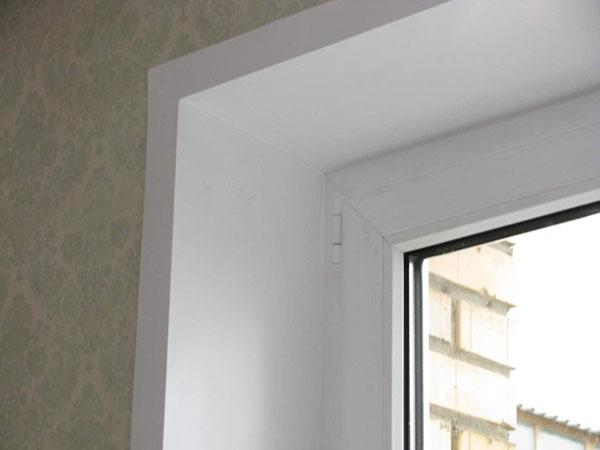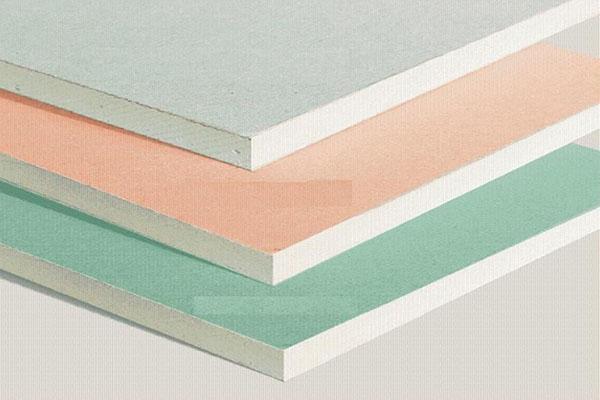Plasterboard slopes: installation feature
 Window decoration is an important part of any renovation. Plasterboard slopes are the best way to make the opening tidy. This building material has many advantages, which makes it possible to use it also for finishing surfaces, technical boxes, walls, creating curved lines. Since its inception drywall has changed and improved many times, but now it is simply irreplaceable in dry construction.
Window decoration is an important part of any renovation. Plasterboard slopes are the best way to make the opening tidy. This building material has many advantages, which makes it possible to use it also for finishing surfaces, technical boxes, walls, creating curved lines. Since its inception drywall has changed and improved many times, but now it is simply irreplaceable in dry construction.
What is drywall and what are its types?

Depending on the purposes for which drywall is needed, it is divided into the following types:
- The budget option is a light gray sheet, used to cover wooden and steel structures of ceilings and walls, for cladding volumetric elements. Suitable only for rooms with low humidity.

- Waterproof plasterboard is a durable and versatile material, usually green. Thanks to a special filler, the canvas is resistant to fungi and mold. Used for installation in bathrooms, kitchens, toilets, loggias and balconies, is a material for various slopes.

- Fire resistant drywall sheets are gray material with red markings. The core of the product can withstand temperatures several times higher than that of other types. It is used for cladding rooms that are exposed to high temperatures, for fire protection structures, and as protection for walls with communications.

- Moisture and fire resistant gypsum board - used to decorate offices, industrial and public spaces.

In this article, we will talk about how to finish drywall window and door slopes on our own, without calling the masters.
Drywall window slopes: preparation
 Window and door slopes are created using the same technology. The process always starts with preparatory activities. Often, plastic windows are installed in most modern houses and apartments. To fix them, polyurethane foam is used, which fills the empty spaces between the window opening and the wall, making the structure strong and airtight.
Window and door slopes are created using the same technology. The process always starts with preparatory activities. Often, plastic windows are installed in most modern houses and apartments. To fix them, polyurethane foam is used, which fills the empty spaces between the window opening and the wall, making the structure strong and airtight.
After fixing the metal-plastic around the perimeter, foam appears, therefore, before installing the slopes from the drywall with your own hands, you should remove it. This is done easily with a construction knife. All actions must be done very carefully. Next, you need to remove the protective film from the window frames, which will also require a construction knife. Then, armed with a corner and a level, you need to mark the marks along which the drywall will be installed. The plane of the slopes should be perpendicular to the window frame.
Next, you need to remove the protective film from the window frames, which will also require a construction knife. Then, armed with a corner and a level, you need to mark the marks along which the drywall will be installed. The plane of the slopes should be perpendicular to the window frame.
Before making slopes on drywall windows, correct measurements should be taken.
In order for the drywall to stay firmly on the wall, you need to use a putty. To begin with, it is worth cleaning the surface of everything superfluous: dirt, brick, remnants of building materials.  Next, apply a primer to the wall to increase the adhesion of the materials. It is also necessary to treat the surface of the drywall with liquid.This can be done before cutting out the details. But, in this case, the material will need to be dried well first, and only then cut.
Next, apply a primer to the wall to increase the adhesion of the materials. It is also necessary to treat the surface of the drywall with liquid.This can be done before cutting out the details. But, in this case, the material will need to be dried well first, and only then cut.
 Using a tape measure, take measurements around the window to set future slopes. Next, transfer these measurements to drywall and cut out rectangles of the required size with a construction knife. All these activities are not too complicated, so you can install drywall window slopes with your own hands without calling the master.
Using a tape measure, take measurements around the window to set future slopes. Next, transfer these measurements to drywall and cut out rectangles of the required size with a construction knife. All these activities are not too complicated, so you can install drywall window slopes with your own hands without calling the master.
Measurements of windows before their production and installation are not always done by professionals. As a result, the products are small, and the remaining space is simply filled with polyurethane foam. The slopes, therefore, should go into this plane, and not only be around the window. The solution will be to fix the plasterboard strips: neither the look nor the functionality will be lost. From excess drywall, you just need to cut the strips to size with a construction knife.
Installation work
 When all the details are ready, you can start creating a gypsum adhesive mixture. It is bought in powder form and mixed following the instructions. For a more thorough mixing, a building mixer or a special nozzle on drill... You should get a mixture of thick sour cream consistency. Further, if necessary, proceed to the installation of narrow strips around the frame. Using a spatula, the adhesive mixture is applied to the pre-primed side of the drywall strip. If desired, you can put glue on the window opening. The next step is to glue the strip to the wall.
When all the details are ready, you can start creating a gypsum adhesive mixture. It is bought in powder form and mixed following the instructions. For a more thorough mixing, a building mixer or a special nozzle on drill... You should get a mixture of thick sour cream consistency. Further, if necessary, proceed to the installation of narrow strips around the frame. Using a spatula, the adhesive mixture is applied to the pre-primed side of the drywall strip. If desired, you can put glue on the window opening. The next step is to glue the strip to the wall.
To make the slopes, you need to use only moisture-resistant drywall.
 Now proceed to the formation of the slopes. The first step is to attach the top panel. It is trimmed and primed. Glue is applied to the wall near the frame, drawing a strip along the window. Put the same amount of the mixture on the plasterboard.
Now proceed to the formation of the slopes. The first step is to attach the top panel. It is trimmed and primed. Glue is applied to the wall near the frame, drawing a strip along the window. Put the same amount of the mixture on the plasterboard.
In order for a piece of drywall to lie clearly horizontally, its position can be checked using two directions of the level.
If any of the sides or any place on the surface needs to be brought closer to the wall, you should lightly tap on it. But the panel cannot be pulled from the wall, because it will remain so uneven. Subsequent work is carried out after the glue of the top panel has set.
Installing side panels
 The side parts of the drywall are attached in the same way as the top. You need to prepare the cut panels, adhesive mixture and tools. Further, in the same way, the wall and drywall are coated with glue and are matched strictly according to the marks. The flatness check is determined using a vertical level in one direction. When all the panels are in place and their glue hardens, measures should be taken to cover the cracks with the same mixture.
The side parts of the drywall are attached in the same way as the top. You need to prepare the cut panels, adhesive mixture and tools. Further, in the same way, the wall and drywall are coated with glue and are matched strictly according to the marks. The flatness check is determined using a vertical level in one direction. When all the panels are in place and their glue hardens, measures should be taken to cover the cracks with the same mixture.
To make beautiful plasterboard slopes with your own hands, it is recommended to use material of the same thickness.
The next and final stage will be finishing work. To keep the ribs perfectly straight, you will need to use metal corners. These products will protect the surface from various types of damage.
 Measure the corners of the required size and cut them off with metal scissors. Mix the finishing putty and apply it to the corner of the slope, then install the metal part. Then apply the plaster mix to the previously primed surface of the slopes. The movements of the trowel should be perpendicular to the slope. Then, using a wide tool, pull the putty along the drywall. When the surface becomes beautiful, wait for it to dry. Then remove any irregularities with an abrasive mesh.
Measure the corners of the required size and cut them off with metal scissors. Mix the finishing putty and apply it to the corner of the slope, then install the metal part. Then apply the plaster mix to the previously primed surface of the slopes. The movements of the trowel should be perpendicular to the slope. Then, using a wide tool, pull the putty along the drywall. When the surface becomes beautiful, wait for it to dry. Then remove any irregularities with an abrasive mesh.
Installation of door slopes
 The process does not fundamentally differ from the installation of window slopes:
The process does not fundamentally differ from the installation of window slopes:
- The surface also needs to be primed, cut out the necessary size drywall rectangles. The side panels should be 10 cm wider than the desired size. Since they will be mounted in a groove previously made in the foam around the door.
- Start installation from the side parts. The drywall should be inserted into the furrow and the angle measured. Further, without removing the sheet, bend it a little and fill the recess with polyurethane foam. Secure the second edge of the panel with masking tape. Fill the voids with foam. Mount the second side slope in the same way.
- Cut the top panel 1 cm wider because it will also fit into the foam recess. In length, the upper slope should lie on the side edges. Pre-coat the panel and wall with a primer and let it dry. In the same way, insert the element into the groove, check the angle, fill the voids with polyurethane foam. Press the structure down and leave to dry for a day.

- Next, carry out finishing work. Initially putty on corners and slopes. Further, if desired, arrange wallpapering or painting with water-based paint.

As you can see, the process of installing door and window slopes from drywall with your own hands is not particularly difficult. To carry out this work, it is enough to have a standard set of tools with you. It is important to purchase high-quality drywall and glue mixture so that your design will last a long time and look aesthetically beautiful. In addition, correct calculations and accuracy of work will also guarantee beauty.